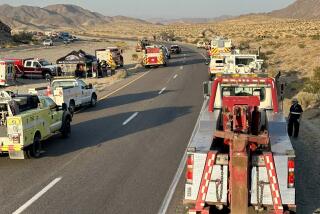Avoiding disaster on foggy roadways
The massive collision on the Long Beach Freeway on Nov. 3 represented a breakdown of order and rational behavior, sending 198 vehicles into a massive junk pile in soupy fog.
With visibility reduced to just a few feet that Sunday morning, one car after another plowed into each other. In some cases, drivers were speeding through the dense fog at 70 mph; in other cases they managed to crash at 20 miles mph, according to witnesses. More than 100 people were treated at eight hospitals after the accident, though miraculously no one was killed.
Fog experts say there were plenty of steps drivers could have taken to reduce their chances of getting trapped and to avoid serious injury.
Sgt. Ted Eichman, chairman of the California Highway Patrol’s fog committee, said fog-related accidents occur because motorists badly misjudge their stopping distance in fog and continue to drive too fast on obscured roadways. “Most of these collisions are just people going too fast through the fog,” he said. “It isn’t the fog killing people.”
The CHP classifies visibility of between 200 and 500 feet as dangerous and less than 200 feet as critical. As visibility decreases into the danger zone, it’s important to pull onto the shoulder as far as possible, he said. If cars are piling into each other, he recommends that drivers parked on the shoulder leave their vehicles, run and hop the freeway fence to reduce the risk of being rear-ended.
In dense fog, drivers often steer their vehicles by following the taillights of the vehicle ahead -- blind reliance on a stranger and hardly responsible driving.
Being able to react and stop if the driver ahead slams on the brakes is not enough. The car ahead may come to an instant standstill if it enters a crash pile, a far different scenario than an emergency stop in which the vehicle ahead of you continues moving forward as it slows.
There are several other fog-related problems that can contribute to accidents.
In daylight fog, drivers often neglect to turn on the car’s headlights. Whether day or night, experts advise driving with low beams on in foggy conditions. High beams create more light scatter that further obscures vision.
Fog lamps are quickly becoming popular, according to the National Highway Traffic Safety Administration. Their beams are aimed lower so not as much light scatters, and they often use amber light that may better penetrate fog.
Most fog lamps are aftermarket items installed by car owners. That means they are not subject to federal testing or approval. The lamps that are offered as options on new cars must conform to general federal standards on lamps.
The growing popularity of fog lamps also is triggering an increase in complaints about glare. In many cases, these fog lamps use high intensity discharge lamps; their blue hue often seems brighter than standard bulbs.
Increased fog lamp use “is accompanied by frequent misuse of these lamps: using fog lamps during conditions other than permitted by most states’ laws,” NHTSA said, meaning they are used when there is no fog.
What’s more, to the extent fog lamps are used to help motorists stay within the lane lines, they are perpetuating a dangerous situation. If you can see only the lane lines immediately in front of your vehicle, it probably means it’s too foggy to be driving, Eichman said.
Eichman said in extremely dense fog, the CHP will close some interstate segments, though that creates another set of problems. Drivers who attempt to find alternative local roads in the fog can face greater risks, because local roads often have just two lanes and drivers may be unfamiliar with the route.
But more could be done.
John Crosby, vice president of engineering at EnviroTech Sensors in Maryland, said highway departments across the country have not made improvements that could help reduce fog-related crashes a priority. EnviroTech makes sensors that can measure visibility and provide police and other authorities with crucial information about emergency conditions.
“There is a lot of technology there, but states haven’t put it together,” Crosby said. “It isn’t sexy. The budget for weather technology is very small. Everything is eaten up by building roads and paying consultants.”
The company’s sensors aren’t cheap, but at $3,500 each, a 100- mile stretch of road can be monitored for about $35,000, he said.
Given the number of deaths associated with fog, spending several million dollars might make sense. According to figures from the NHTSA, 628 people died in crashes associated with foggy conditions in 2001. That’s far more deaths than were associated with defective Firestone tires on Ford Explorers, a matter that created a national uproar.
*
Ralph Vartabedian cannot answer mail personally but responds in this column to automotive questions of general interest. Please do not telephone. Write to Your Wheels, Business Section, Los Angeles Times, 202 W. 1st St., Los Angeles, CA 90012. E-mail: ralph.vartabedian @latimes.com.
More to Read
Sign up for Essential California
The most important California stories and recommendations in your inbox every morning.
You may occasionally receive promotional content from the Los Angeles Times.










